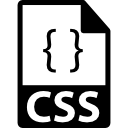CSS: Difference between revisions
Mr. MacKenty (talk | contribs) |
Mr. MacKenty (talk | contribs) |
||
| Line 15: | Line 15: | ||
== CSS Syntax == | == CSS Syntax == | ||
This image is used with gratitude from W3 schools.<ref>https://www.w3schools.com/css/css_syntax.asp</ref> | |||
[[File:Css syntax.png]] | [[File:Css syntax.png]] | ||
Revision as of 14:21, 21 August 2017

Cascading Style Sheets (CSS) is a style sheet language used for describing the presentation of a document written in a markup language. Although most often used to set the visual style of web pages and user interfaces written in HTML and XHTML, the language can be applied to any XML document, including plain XML, SVG and XUL, and is applicable to rendering in speech, or on other media. Along with HTML and JavaScript, CSS is a cornerstone technology used by most websites to create visually engaging webpages, user interfaces for web applications, and user interfaces for many mobile applications.[2]
Although this is debatable, CSS is a Domain-specific declarative language. It serves a very specific purpose in a rather narrow capacity when compared to other formal programming languages.
Basic ideas[edit]
CSS Syntax[edit]
This image is used with gratitude from W3 schools.[3]

Selectors[edit]
Selectors define to which elements a set of CSS rules apply. [4]
Click here for an interactive selector tool
Standards[edit]
- Define CSS
- Discuss structure of CSS and the cascade
- Demonstrate knowledge and skill using selectors
- Demonstrate knowledge and skill using values and units
- Demonstrate knowledge and skill using text properties
- Demonstrate knowledge and skill using basic visual properties
- Demonstrate knowledge and skill using padding, borders and margins
- Demonstrate knowledge and skill using colors, borders and backgrounds
- Demonstrate knowledge and skill using floating and positioning
- Demonstrate knowledge and skill using box model